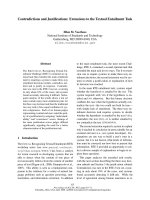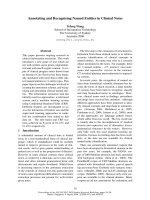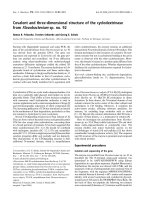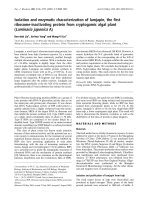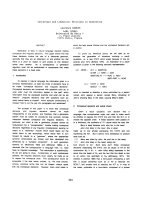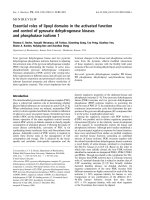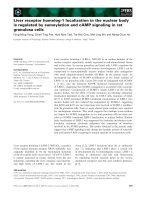Báo cáo khoa học: Bacteriophages and Pathogenic Vibrio spp in the Aquatic Environment
Bạn đang xem bản rút gọn của tài liệu. Xem và tải ngay bản đầy đủ của tài liệu tại đây (1.71 MB, 34 trang )
Bacteriophages and Pathogenic Vibrio spp in
the Aquatic Environment
Iddya Karunasagar
Products, Trade and Marketing service
Fisheries and Aquaculture Department
Food and Agriculture Department, Rome, Italy
Bacteriophages: viruses that ‘devour’ bacteria
Bacteriophages in aquatic environment
• Viruses, most abundant life forms. Most of these are
bacteriophages
• Viral lysis removes 20-40% of the standing stock of
prokaryotes every day
• Highly diverse – may have linear or circular dsDNA, linear or
circular ssDNA, linear ssRNA or dsRNA
LYTIC AND LYSOGENIC STAGES
TRANSDUCTION - BACTERIOPHAGES AS VECTORS OF GENE
TRANSFER IN THE NATURAL ENVIRONMENT
Lambdoid phages
• Lambdoid phages are dsDNA phages. They can integrate and
excise from the host chromosome catalysed by a phage
integrase.
• Many lambdoid phages have been shown to encode bacterial
virulence factors eg shiga toxins (Stx1 and STX2) encoded
within pathovars of Escherichia coli.
Examples of bacteriophages carrying
virulence genes
Filamentous bacteriophage
• Contain a circular single-stranded deoxyribonucleic acid
(ssDNA) genome packaged into long filaments.
• Do not reproduce by lysing bacteria; instead, they are
secreted into the environment without killing the host.
• Some filamentous phages enhance the virulence of their host
organisms, the most striking example being the CTXφ of Vibrio
cholerae, which encodes cholera toxin.
• Toxin-coregulated pilus (TCP), an essential colonization factor
that is also the receptor for CTXφ.
• The genes involved in the biosynthesis of TCP reside in a
pathogenicity island (VPI)
Vibrio spp
• Comma shaped gram negative bacteria native to the aquatic
environment.
• Mostly halophilic, some are found in fresh waters
• Over 80 species identified
• Human pathogens
– Vibrio cholerae
– Vibrio parahaemolyticus
– Vibrio vulnificus
•
Vibrio spp
• Pathogens of aquatic animals
– Vibrio harveyi
– Vibrio anguillarum
– Alivibrio salmonicida
– Vibrio penaecida
– Vibrio vulnificus
– Vibrio owensii
• Vibrio harveyi clade includes eleven species: V. harveyi, V.
alginolyticus, V. parahaemolyticus, V. campbellii, V.
rotiferianus, V. mytili, V. natriegens, V. azureus, V.
sagamiensis, V. owensii, V. jasicida
Vibrio choleraeVibrio cholerae genetically and serologically genetically and serologically
highly diversehighly diverse
from human disease point of viewfrom human disease point of view
Choleragenic Non-choleragenic
O1 and O139 serotypes Non-O1/O139 serotypes
Classification SchemeClassification Scheme
Toxigenic V. cholerae
O1
Division into 2 biotypes
inaba ogawa hikojima
A & B
(A little C) Antigens
A & C
O139
A, B, C
Each O1 biotype can have 3 serotypes
Classical
El Tor
Designed using information presented in review by NS Crowcroft. 1994. Cholera: Current Epidemiology. The
Communicable Disease Report. 4(13): R158-R163.
Division into ribotypes
Division into 2 epidemic serotypes
Choleragenic Vibrio cholerae
• Cholera toxin gene comes from filamentous bacteriophage
CTXφ
• ctxAB gene sequence is highly variable between classical and
el Tor strains
• Till 1993, only O1 V.cholerae was recoginsed as choleragenic.
Isolates from outbreaks that occurred in India and Bangladesh
during 1992-93 did not belong to O1 serotype. Since it was
different from 138 V. cholerae serovars known then, this was
designated O139.
• Molecular analysis of O139 V. cholerae suggests that this is
very closely related to El Tor variety of V. cholerae O1. It
seems to have acquired genes for new lipopolysaccharides.
Choleragenic Vibrio cholerae
• In the aquatic environment, it is possible to find ctx-ve O1 V.
cholerae.
• Under suitable environmental conditions, toxigenic V.
cholerae produce CTXφ particles that can infect ctx-ve O1 V.
cholerae and convert them into toxigenic strains.
• Strains isolated from outbreaks contain multiple copies of
CTXφ
Source: Nelson et al., 2009
Choleragenic Vibrio cholerae
• Can non-O1/O139 V. cholerae aquire bacteriophage CTXφ and
become choleragenic?
• Toxin-coregulated pilus (TCP), an essential colonization factor
that is also the receptor for CTXφ.
• Most non-O1/O139 V. cholerae are negative for TCP.
• Over 100 years after discovery of V. cholerae O1, eight
pandemics of cholera have been recorded. These involved O1
V. cholerae and O139 serovar more recently.
• Evolution of O139 is not due to ctx gene acquisition by a new
serotype, but due to acquisition of new somatic
lipopolysaccharide producing genes by an el Tor strain.
Choleragenic Vibrio cholerae
• VPI is highly stable, but it can excise from the chromosome
and form a circular intermediate at very low rates. It is non-
self mobile, but experimentally, VPI could be transferred
between O1 strains of V. cholerae by generalized
transduction.
• Since CTXphi uses TCP as its receptor for infecting recipient
cells, the acquisition of TCP pathogenicity island is the most
likely initial genetic event required for the evolution of
epidemic strains.
Lytic bacteriophages of choleragenic V. cholerae
• It was discovered in the 1930s that cholera cases were
positively correlated with the isolation of vibriophages in the
aquatic environment.
• V. cholerae typically outnumbers lytic bacteriophages
immediately after passage from the host.
• Vibriophages will subsequently increase in density, ultimately
promoting a decline in the outbreak
Filamentous phages in Vibrio spp
• Phages related to the filamentous phages based on the
replication protein-encoding gene are present in nearly every
Vibrio genome sequenced to date including V. fischeri, Vibrio
parahaemolyticus, Vibrio mimicus, V. shilonii, Vibrio
splendidus, and V. vulnificus.
• The V. parahaemolyticus filamentous phages exhibited
significant amino acid identity and were most related to two
V. harveyi phages present in the genomes of two different V.
harveyi strains that were sequenced recently.
Source: Hazen et al., 2010
• Global distribution
• Human illness is associated with strains producing a
thermostable direct hemolysin (TDH) or TDH-related
hemolysin (TRH)
• Both these genes are present in ‘pathogenicity islands’ and
have been possibly derived by lateral gene transfer.
• tdh+ and trh+ strains account for only a small proportion of
environmental V. parahaemolyticus population (1-2%).
• Pandemic clone of V. parahaemolyticus carries a filamentous
phage f237. No virulence gene has yet been characterised and
some pandemic strains lack f237.
Vibrio parahaemolyticus
• Possibly, in addition to tdh and trh genes, other genes are
involved in virulence.
• TDH is a pore forming cytotoxin
• T3SS-1 is present in both clinical and environmental strains
and gas the same G+C content as the rest of genome
• T3SS-2 is present in most clinical strains and has G+C content
less than rest of genome suggesting that this may an
integrative element like pathogenicity islands
• T3SS-2 is present on chromosome 2 as are tdh1 and tdh2. This
may be coding for an enterotoxin
Bacteriophages in virulence of other
pathogenic Vibrio spp
• Bacteriophage VHML confers virulence to V. harveyi (Munro et
al., 2003).
• Bacteriophage VOB likely to be responsible for virulence of V.
owensii (Busico-Salcedo and Owens, 2013).

